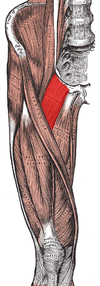Pectineus muscle
| Pectineus muscle |
|---|

|
| Upper thigh muscles of man |
| origin |
| Pubic bone ( pecten ossis pubis , tuberculum pubicum , lig. Pubicum sup. ) |
| approach |
| Thigh bone ( linea pectinea or labium mediale ) |
| function |
| Hip joint flexor , adduction |
| Innervation |
| Femoral nerve , obturator nerve |
| Spinal segments |
| L2, L3 |
The pectineus muscle ( Latin for "comb muscle") is a muscle on the inside of the thigh . In animals, it limits the thigh triangle ( Trigonum femorale ) from behind. The pectineus muscle is united with the adductor longus muscle in ungulates and is part of the upper shell . Occasionally the fusion with the adductor longus muscle is also found in dogs .
The muscle flexes the hip joint , pulls the thigh toward the center of the body (adduction), and helps twist it outward. It is innervated by the femoral nerve and the anterior branch ( ramus anterior ) of the obturator nerve , which originate in the spinal cord segments L2 – L3 and L2 – L4.
See also
- Musculus adductor brevis (Latin for "short adductor")
- Musculus adductor longus (Latin for "long adductor")
- Musculus adductor magnus (Latin for "large adductor")
- Musculus gracilis (Latin for "slim muscle")
literature
- Franz-Viktor Salomon: muscle tissue . In: Anatomy for veterinary medicine . 2nd ext. Edition. Enke, Stuttgart 2008, ISBN 978-3-8304-1075-1 , pp. 147-234.